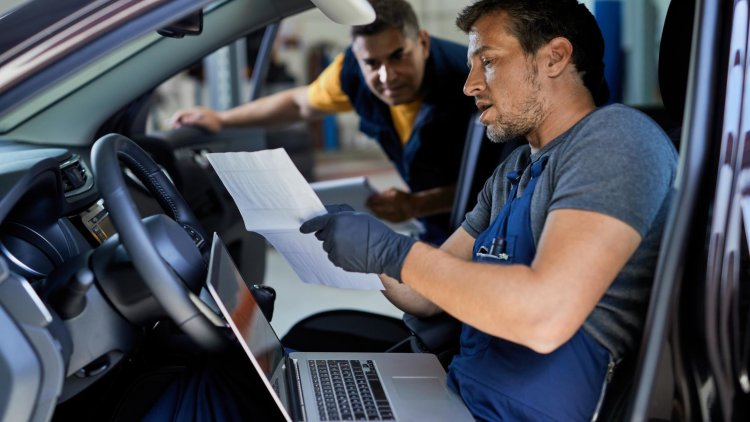Stay ahead with software updates for your car - for a safer, smarter, and more connected driving experience
Rev up your driving experience with software updates for your car! Stay ahead of the game with smarter, safer, and more connected technology

As technology advances, our vehicles are becoming more advanced too. Software updates for cars are becoming increasingly common and are necessary to keep your vehicle up to date with the latest features and technologies. These updates are designed to improve the driving experience, increase safety, and provide more convenience to drivers. Here are some of the benefits of software updates for cars.
Improved Performance
Software updates for cars can improve the overall performance of your vehicle. Manufacturers release updates to fix bugs and glitches in the software, which can affect the car’s performance. Updates can also optimize the car’s engine and transmission for better fuel economy, resulting in cost savings in the long run. By updating your car’s software regularly, you can ensure that your vehicle is running at peak performance.
Increased Safety
One of the most significant benefits of software updates for cars is increased safety. Updates can include new safety features, such as blind-spot monitoring, collision warning, lane departure warning, and emergency braking. These features can help drivers avoid accidents and provide an extra layer of protection on the road. By keeping your car’s software up to date, you can ensure that you have access to the latest safety features available.
Better Connectivity
Today’s cars are more connected than ever before. With software updates, you can enjoy better connectivity options in your car. Updates can include new infotainment systems that provide better integration with your smartphone or other devices. You can access your music, contacts, and navigation more easily, making your driving experience more enjoyable. Updates can also include new wireless connectivity options, such as Wi-Fi and Bluetooth, which can make it easier to connect to the internet and other devices while on the go.
Enhanced User Experience
Software updates can enhance the user experience of your car. Updates can include new features that make your driving experience more comfortable and convenient, such as voice commands, touchscreens, and improved climate control systems. Updates can also improve the overall aesthetics of your car’s interior, making it more attractive and stylish.
Cost Savings
Regular software updates can help you save money in the long run. Updates can fix software bugs that can affect your car’s performance and reduce its lifespan. By keeping your car’s software up to date, you can ensure that your vehicle is running at peak performance, which can help you avoid costly repairs and replacements down the line. Updates can also optimize your car’s engine and transmission for better fuel economy, resulting in cost savings at the pump.
Better Security
As cars become more connected, the risk of cyber-attacks increases. Software updates can help protect your car from these threats. Updates can include security patches that address vulnerabilities in the car’s software and prevent unauthorized access to your car’s systems. By keeping your car’s software up to date, you can ensure that your vehicle is protected against the latest threats.
Improved Resale Value
Software updates can help improve the resale value of your car. By keeping your car’s software up to date, you can ensure that it has the latest features and technologies, making it more attractive to potential buyers. Updates can also improve the car’s overall performance, safety, and reliability, which can increase its resale value.
Software updates for cars are becoming increasingly important as technology advances. These updates can improve the overall performance of your vehicle, increase safety, provide better connectivity options, enhance the user experience, save you money, improve security, and even improve the resale value of your car. By keeping your car’s software up to date, you can ensure that your vehicle is running at peak performance and has access to the latest features and technologies available.

How do software updates for cars work, and what is the process for installing them?
Software updates for cars are designed to keep the car's electronic systems up to date with the latest features, technologies, and bug fixes. The process for installing software updates can vary depending on the make and model of the car, as well as the type of update being installed.
Generally, there are two types of software updates for cars: dealer-installed updates and over-the-air (OTA) updates. Dealer-installed updates typically require the owner to bring the car to a dealership or service center to have the update installed. The dealership will use specialized equipment to connect to the car's onboard computer and install the update. This procedure can take anywhere from a few minutes to many hours, depending on the insolubility of the update.
OTA updates, on the other hand, can be downloaded and installed directly to the car's electronic systems without the need to visit a dealership. This is typically done over a wireless internet connection, either through the car's built-in cellular data connection or by connecting to a Wi-Fi network. The car's software will automatically check for available updates and notify the owner when a new update is available. The owner can then choose to download and install the update at their convenience, typically by following a series of prompts on the car's infotainment system.
Regardless of the type of update being installed, it's important to follow the manufacturer's instructions carefully to ensure that the update is installed correctly and without any issues. This may include backing up any important data on the car's electronic systems before installing the update and ensuring that the car's battery is fully charged to prevent any interruptions during the update process. It's also important to note that some updates may require the car to be parked in a specific location or require certain conditions, such as a certain temperature range, to be met before the update can be installed.
The process for installing software updates for cars can vary depending on the make and model of the car, as well as the type of update being installed. It's important to follow the manufacturer's instructions carefully and ensure that the update is installed correctly to ensure that the car's electronic systems are up to date and functioning properly.
FAQs
a. How often do cars typically receive software updates?
Software updates for cars can vary in frequency depending on the manufacturer and the type of update being released. Some updates may be released quarterly or yearly, while others may be released more frequently as needed.
b. Can car owners install software updates themselves, or do they need to go to a dealership?
The answer to this question depends on the type of update being installed. Some updates may require a dealership or service center to install, while others can be installed directly by the owner using over-the-air (OTA) updates. However, it's important to follow the manufacturer's instructions carefully to ensure that the update is installed correctly and without any issues.
c. How long does it typically take to install a software update for a car?
The time required to install a software update can vary depending on the complexity of the update and the method of installation. Dealer-installed updates may take several hours to complete, while OTA updates can often be installed in a matter of minutes.
d. Do software updates for cars cost money?
Most software updates for cars are provided by the manufacturer free of charge, although some updates may require payment if they include premium features or functionality.
e. Can software updates improve a car's performance or fuel efficiency?
Yes, software updates can often improve a car's performance, fuel efficiency, and overall driving experience. Updates may include bug fixes, performance optimizations, and new features or technologies that can enhance the car's capabilities.
f. What happens if something goes wrong during a software update for a car?
If something goes wrong during a software update, it's important to contact the manufacturer or a dealership as soon as possible to diagnose and fix any issues. In some cases, a failed update may require the car to be taken to a service center for repairs, although most issues can be resolved remotely.












